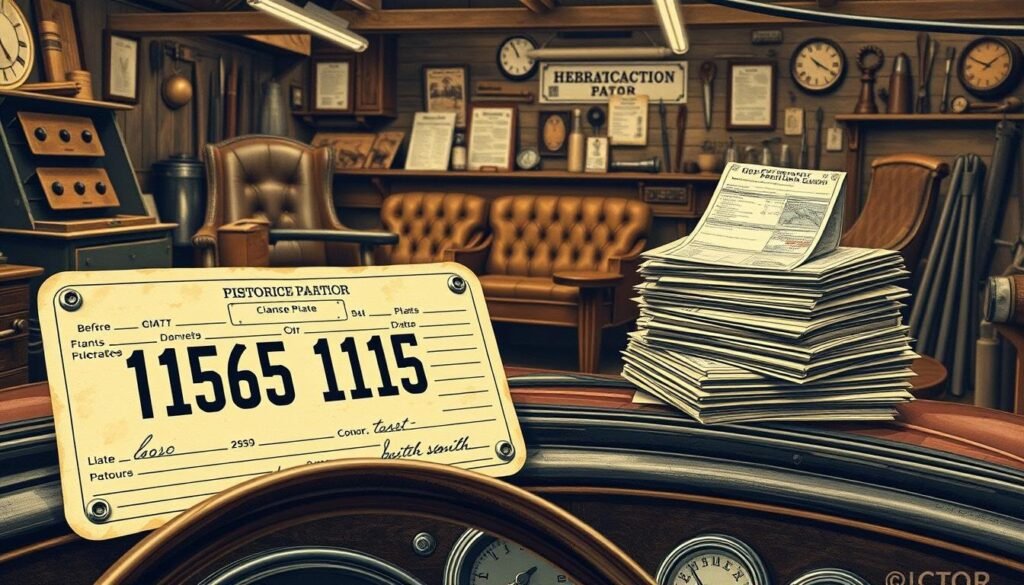Obtain a Historical License Plate for Your Car: Registering your vehicle as a historical one is a great way to show off its unique history. A historical license plate is more than just a registration. It’s a badge of honor that shows your vehicle’s significance.
To start the license plate application process, you need to know the requirements for historical vehicle registration. This includes verifying your vehicle’s age, condition, and historical significance. By following these steps, you can get a historical license plate that highlights your vehicle’s importance.
Understanding the process and benefits of historical vehicle registration helps you navigate the application process easily. This guide will show you the necessary steps to get a historical license plate for your vehicle.
Contents
- 1 Understanding Historical License Plates
- 2 Vehicle Eligibility Requirements
- 3 How to Get a Historical License Plate for My Vehicle
- 4 Required Documentation and Evidence
- 5 Costs and Fees Associated with Historical Plates
- 6 Restrictions and Usage Guidelines
- 7 After Receiving Your Historical License Plates
- 8 Conclusion: Obtain a Historical License Plate for Your Car
- 9 FAQ
- 9.1 What is a historical license plate?
- 9.2 How do I know if my vehicle is eligible for a historical license plate?
- 9.3 Are there any restrictions on using a historical license plate?
- 9.4 How much does it cost to obtain a historical license plate?
- 9.5 How do I properly display my historical license plate?
- 9.6 What are the benefits of having a historical license plate?
Understanding Historical License Plates
Getting a historical license plate for your car is a special way to show off its history. These plates are for cars that are old or have a special story. They let owners keep and share their car’s heritage.
To get a historical license plate, you need to know what your state’s DMV requires. These rules often depend on the car’s age, condition, and its historical value.
| State | Minimum Vehicle Age | Required Documentation |
|---|---|---|
| California | 25 years | Proof of ownership, vehicle registration |
| New York | 30 years | Vehicle registration, historical vehicle certificate |
Knowing these rules is key to a successful application. By getting a historical license plate, you follow the law and help keep car history alive.
Vehicle Eligibility Requirements
Before you apply for a historical license plate, you need to know if your vehicle qualifies. The process checks if your car meets certain criteria.
Acceptable Modifications
Some vehicles with modifications can still get historical plates. Acceptable modifications are those that keep the car’s original history intact. For example, safety upgrades or changes to meet current laws are okay.
Prohibited Alterations
But, big changes that alter the car’s history are not allowed. This includes major engine or body changes. These changes can change what makes the car historically significant.
To see if your car fits, check your state’s DMV rules. Knowing these rules helps make the registration process easier.
How to Get a Historical License Plate for My Vehicle
If you want a historical license plate for your vintage car, here’s how. It’s a simple process that needs some basic documents.
To start your license plate application, you’ll need to:
- Gather the necessary documents, including proof of vehicle ownership and age.
- Fill out the application form for historical license plates.
- Submit the application and supporting documents to your local DMV office.
For vintage car registration, make sure your car fits the criteria. It should be old enough and have historical value.
After you apply, the authorities will review it. If they approve, you’ll get historical license plates for your car.
Here are some important things to remember:
- Make sure all documents are correct and complete.
- Check with your local DMV for specific requirements, as these can vary.
- Be ready for any fees related to the application and plates.
By following these steps, you can get a historical license plate for your vintage car.
Required Documentation and Evidence
To get a historical license plate, you need certain documents. These prove your vehicle’s age and its historical value. The needed documents can change based on where you live. So, always check with your local Department of Motor Vehicles (DMV) for the latest info.
The main documents you’ll need include:
- Proof of vehicle age, such as the vehicle’s title or registration
- Historical records or documents that show the vehicle’s importance
- Photos of the vehicle, showing its original or restored state
Here’s what kind of documents you might need:
| Document Type | Description | Example |
|---|---|---|
| Proof of Age | Vehicle title or registration showing the vehicle’s age | Vehicle title with the manufacture date |
| Historical Significance | Records or documents highlighting the vehicle’s historical importance | Letter from a historical society verifying the vehicle’s significance |
| Photos | Images showcasing the vehicle’s original or restored condition | Photos of the vehicle from various angles, highlighting its original parts |
Make sure all your documents are correct and complete. This will help avoid delays in your application. By providing the right evidence, you can get a historical license plate for your vehicle.
Costs and Fees Associated with Historical Plates
When you start the registration process, you’ll find several costs for historical license plates. It’s important to know these expenses to plan your budget.
The costs fall into a few categories:
- Application fees: These are the initial costs for processing your application.
- Registration fees: Annual or biennial fees required for the registration of your vehicle.
- Plate fees: Costs associated with the production and issuance of historical license plates.
It’s essential to check with your local DMV for the most accurate and up-to-date fee information, as these costs can vary by state.
Planning for these expenses will help make the registration process smoother for your historical vehicle.
Restrictions and Usage Guidelines
After getting historical license plates for your car, it’s key to know the rules. These plates have specific uses and times. You must follow certain laws when using them.
Your car must meet certain criteria to use these plates. The plates should be on the front and back of your car. They should be clean and easy to read.
| Usage Guidelines | Description |
|---|---|
| Display Requirements | Plates must be displayed on the front and rear of the vehicle. |
| Vehicle Usage | Vehicles with historical plates may have restrictions on commercial use. |
| Registration Renewal | Historical vehicle registration may require periodic renewal. |
Also, cars with these plates might need special insurance. They might have rules on when and where you can drive. Knowing theseusage guidelines helps you follow the law.

Following these rules lets you show off your historical plates legally.
After Receiving Your Historical License Plates
Getting your historical license plates is a big step in your vintage car journey. Now that you have them, it’s key to know how to show and care for them.
You shouldsecurely attachthe historical license plates to your vehicle as per your state’s regulations. Make sure they are clearly visible and not covered by any accessories or frames.
As a holder of historical license plates, you may need to follow ongoing rules. This includes periodic inspections or registration renewals. Knowing these rules helps you avoid penalties.
By following these guidelines, you can show off your vintage car while meeting all the rules. Proper display and care also help keep your historical license plates in great shape.
Conclusion: Obtain a Historical License Plate for Your Car
You now know how to get a historical license plate for your car. This includes the rules and what kind of car is eligible. By following this guide, you can easily apply and enjoy your car’s historical look.
First, make sure your car fits the eligibility rules. You’ll also need to collect the right documents and pay the costs. Once you have your plates, you can show off your car’s historical charm.
Getting a historical license plate makes your car more authentic. It also helps keep car history alive. If you qualify, go ahead and apply. You’ll get to enjoy the perks of owning a historical vehicle.
See Also: Are Private License Plates Legal? Comprehensive Guide!
FAQ
What is a historical license plate?
A historical license plate is for cars that are very old or special. They are for classic cars and other vehicles with historical value.
How do I know if my vehicle is eligible for a historical license plate?
Check with your state’s DMV to see if your car qualifies. They look at the car’s age, condition, and any changes made.
Are there any restrictions on using a historical license plate?
Yes, there are rules. You might not be able to drive it every day. Or, you must display the plate in a specific way.
How much does it cost to obtain a historical license plate?
Costs vary by state. You’ll pay for the plate and possibly other fees for registration.
How do I properly display my historical license plate?
You must put the plate on the front and back of your car. Make sure it’s attached well and easy to see.
What are the benefits of having a historical license plate?
It preserves your car’s history and gives it a unique ID. It might also lower registration fees or exempt you from some rules.

I’m Karsyn Marsh, a blogger from a small village in Texas. I enjoy writing about many topics, and right now, I’m focused on license plates. I share helpful information and facts on LicensePlateFacts.com.



